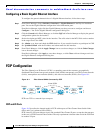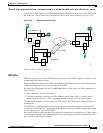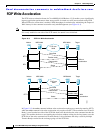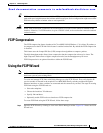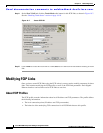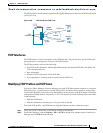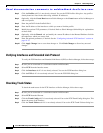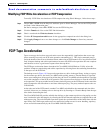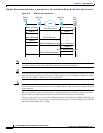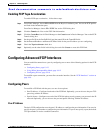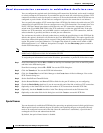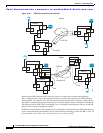
Send documentation comments to mdsfeedback-doc@cisco.com.
19-9
Cisco MDS 9000 Family Fabric Manager Configuration Guide
OL-6965-03, Cisco MDS SAN-OS Release 2.x
Chapter 19 FCIP Configuration
Modifying FCIP Links
The FCIP profile’s local IP address determines the Gigabit Ethernet port where the FCIP links terminate
(see Figure 19-8).
Figure 19-8 FCIP Profile and FCIP Links
FCIP Interfaces
The FCIP interface is the local endpoint of the FCIP link and a VE port interface. All the FCIP and E
port parameters are configured in context to the FCIP interface.
The FCIP parameters consist of the following:
• The FCIP profile determines which Gigabit Ethernet port initiates the FCIP links and defines the
TCP connection behavior.
• Peer information.
• Number of TCP connections for the FCIP link.
• E port parameters—trunking mode and trunk allowed VSAN list.
Modifying FCIP Profiles and FCIP Links
You can use Fabric Manager or Device Manager to modify FCIP links between switches or create new
FCIP links. First, you must create or modify FCIP profiles, and then bind the interfaces to the profile.
To bind an FCIP profile to an interface, use the IP address of the interface in the FCIP profile’s IP address
configuration. Profile numbers range from 1 to 255. The interface associated with a profile can be either
of the following:
• Ethernet PortChannel
• Ethernet subinterface slot and port (or slot, port, and VLAN ID)
To modify FCIP profiles and FCIP links on a Gigabit Ethernet interface, follow these steps.
Step 1 Verify that you are connected to a switch that contains an IPS module.
Step 2 From Fabric Manager, choose Switches > ISLs > FCIP in the Physical Attributes pane. From Device
Manager, choose FCIP from the IP menu.
IP
network
FCIP link 1
FCIP link 3
Switch 1
Switch 2
Switch 4
FCIP
interfaces
Gigabit
Ethernet
FCIP
profile
91558




